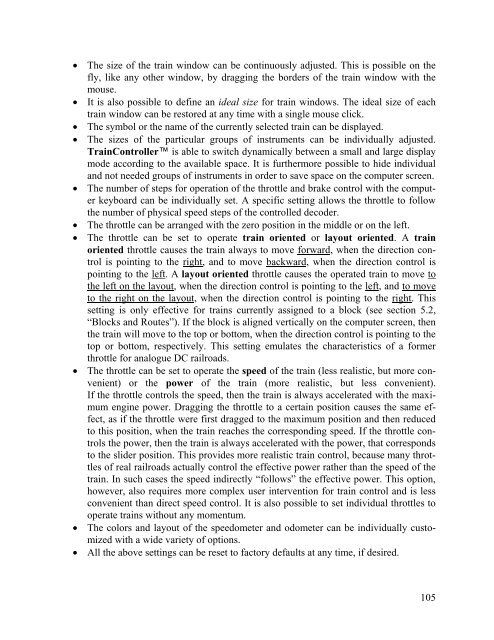TrainController Gold and Silver - Freiwald Software
TrainController Gold and Silver - Freiwald Software
TrainController Gold and Silver - Freiwald Software
You also want an ePaper? Increase the reach of your titles
YUMPU automatically turns print PDFs into web optimized ePapers that Google loves.
• The size of the train window can be continuously adjusted. This is possible on the<br />
fly, like any other window, by dragging the borders of the train window with the<br />
mouse.<br />
• It is also possible to define an ideal size for train windows. The ideal size of each<br />
train window can be restored at any time with a single mouse click.<br />
• The symbol or the name of the currently selected train can be displayed.<br />
• The sizes of the particular groups of instruments can be individually adjusted.<br />
<strong>TrainController</strong> is able to switch dynamically between a small <strong>and</strong> large display<br />
mode according to the available space. It is furthermore possible to hide individual<br />
<strong>and</strong> not needed groups of instruments in order to save space on the computer screen.<br />
• The number of steps for operation of the throttle <strong>and</strong> brake control with the computer<br />
keyboard can be individually set. A specific setting allows the throttle to follow<br />
the number of physical speed steps of the controlled decoder.<br />
• The throttle can be arranged with the zero position in the middle or on the left.<br />
• The throttle can be set to operate train oriented or layout oriented. A train<br />
oriented throttle causes the train always to move forward, when the direction control<br />
is pointing to the right, <strong>and</strong> to move backward, when the direction control is<br />
pointing to the left. A layout oriented throttle causes the operated train to move to<br />
the left on the layout, when the direction control is pointing to the left, <strong>and</strong> to move<br />
to the right on the layout, when the direction control is pointing to the right.<br />
This<br />
setting is only effective for trains currently assigned to a block (see section 5.2,<br />
“Blocks <strong>and</strong> Routes”). If the block is aligned vertically on the computer screen, then<br />
the train will move to the top or bottom, when the direction control is pointing to the<br />
top or bottom, respectively. This setting emulates the characteristics of a former<br />
throttle for analogue DC railroads.<br />
• The throttle can be set to operate the speed of the train (less realistic, but more convenient)<br />
or the power of the train (more realistic, but less convenient).<br />
If the throttle controls the speed, then the train is always accelerated with the maximum<br />
engine power. Dragging the throttle to a certain position causes the same effect,<br />
as if the throttle were first dragged to the maximum position <strong>and</strong> then reduced<br />
to this position, when the train reaches the corresponding speed. If the throttle controls<br />
the power, then the train is always accelerated with the power, that corresponds<br />
to the slider position. This provides more realistic train control, because many throttles<br />
of real railroads actually control the effective power rather than the speed of the<br />
train. In such cases the speed indirectly “follows” the effective power. This option,<br />
however, also requires more complex user intervention for train control <strong>and</strong> is less<br />
convenient than direct speed control. It is also possible to set individual throttles to<br />
operate trains without any momentum.<br />
• The colors <strong>and</strong> layout of the speedometer <strong>and</strong> odometer can be individually customized<br />
with a wide variety of options.<br />
• All the above settings can be reset to factory defaults at any time, if desired.<br />
105










